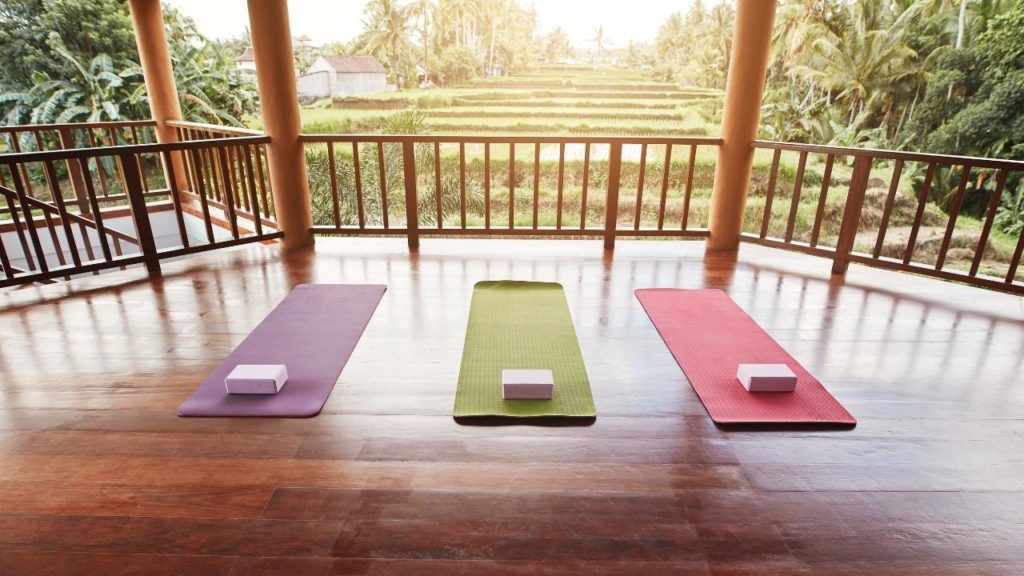A Yoga shala is a room or hall specifically designed for Yoga practice. It is often large and has a smooth, hard surface so students can practice without slipping or injuring themselves. The walls are often painted with calming colors, and the ceilings are high, so there is plenty of space to move around.
The benefits of practicing Yoga in a shala are numerous. First and foremost, a shala provides a safe environment to practice. The smooth surface prevents injuries, and the high ceilings allow students to move freely without hitting their heads. Additionally, the calm atmosphere created by the painted walls and ceilings helps to focus the mind and create an optimal environment for learning.
Table of Contents
- What is a Yoga Shala?
- What are the benefits of practicing Yoga in a Shala?
- How to find da Yoga Shala near you?
- What to bring to your first Yoga Class in a Shala?
- Tips for beginners attending their first Yoga Class in a Shala
- The importance of establishing a personal Yoga practice
- Cultural and Historical Context
- Ventilation and Temperature
- Lighting
- Acoustics
- Storage and Facilities
- Space Requirements
- General Guidelines
- Personal Care
- Electronic Devices
- Types of Shalas
- Cost Considerations
What is a Yoga Shala?

The shala is an essential part of the Yoga practice. It is where you learn the poses and how to do them correctly. It is also a place where you can come to deepen your Yoga practice and learn more about Yoga philosophy. In a shala, you can expect to find a calm and peaceful environment that is conducive to Yoga practice.
The shala should be large enough so that you can move around freely and not feel cramped. The shala should also have a smooth, hard surface so that you can practice without slipping or injuring yourself. The walls of the Yoga shala are often painted with calming colors, and the ceilings are high, so there is plenty of space to move around.
What are the benefits of practicing Yoga in a Shala?
A Yoga shala is a great place to deepen your Yoga practice. In a Yoga shala, you can expect to find knowledgeable teachers to help you learn more about Yoga poses and how to do them correctly. You can also learn more about Yoga philosophy in a Yoga shala. In addition, the large space in a Yoga shala allows students to move around freely and practice different poses. This is especially beneficial if you are new to Yoga and are still learning the poses.
How to find da Yoga Shala near you?
If you are looking for a shala near you, the best place to start is by doing a Google search. Simply type in “yoga shala + your city” and you will likely find several Yoga shalas in your area. You can also check online directories such as YogaTrail.com or findyoga.net. These online directories list Yoga shalas worldwide, so you are sure to find one near you.
When you find a Yoga shala that looks promising, make sure to call ahead and ask about their rates, policies, and what type of Yoga classes they offer. You want to ensure that the Yoga shala is a good fit for your needs before committing to anything.
What to bring to your first Yoga Class in a Shala?

When you attend your first Yoga class in a shala, there are a few things you will need to bring with you. First and foremost, you will need to bring a Yoga mat. If you do not have a Yoga mat, you can often rent or borrow one from the Yoga shala. You will also need to bring water and a towel. It is important to stay hydrated during Yoga class, so be sure to bring a water bottle along. Additionally, a towel helps wipe down the Yoga mat after class.
If you have other props or accessories you like to use during Yoga class, such as a block or strap, be sure to bring those with you as well. And finally, make sure to wear comfortable clothing that allows you to move freely. Yoga pants and a tank top are usually good choices.
With these items in hand, you are ready for your first Yoga class in a shala!
Tips for beginners attending their first Yoga Class in a Shala
If you are a beginner attending your first Yoga class in a shala, you should keep a few things in mind. First and foremost, it is important to be respectful of the other students in the class. Yoga is a practice that should be done with humility and respect for others.
It is also important to come to class on time. Yoga classes often start with a guided meditation or breathwork, and if you are late, you will miss out on that. If you are unable to make it to class on time, be sure to let the teacher know ahead of time.
Be sure to wear comfortable clothing that allows you to move freely. And finally, make sure to bring a Yoga mat, water bottle, and towel with you to class.
The importance of establishing a personal Yoga practice
If you are serious about your Yoga practice, it is important to establish a personal Yoga practice. A personal Yoga practice allows you to deepen your Yoga journey and learn more about yourself. In addition, a personal Yoga practice allows you to practice Yoga in the comfort of your own home, which can be especially helpful if you are new to Yoga.
There are many different ways to establish a personal Yoga practice. One way is to find a Yoga video or online class that you like and do it at home regularly. Another way is to find a Yoga studio near you and attend classes regularly. Or, you can simply find a quiet spot in your home and do some Yoga poses and breathing exercises on your own.
The most important thing is to find what works best for you and to be consistent with it. If you can commit to practicing Yoga regularly at home, you will see big benefits in your Yoga practice and in your life overall.
Cultural and Historical Context
The word “shala” comes from Sanskrit, where it simply means “home” or “place of shelter.” In traditional Indian yoga practice, shalas were more than just exercise spaces—they were sacred places of learning where the guru-student (teacher-disciple) relationship flourished. Originally, yoga was taught one-on-one in these intimate settings, with knowledge passed down through direct transmission from teacher to student.
Modern shalas have evolved to accommodate group classes while maintaining the spiritual essence of traditional practice spaces. Unlike conventional fitness studios, authentic shalas still emphasize the philosophical and spiritual aspects of yoga alongside physical practice. Many contemporary shalas integrate elements of traditional design with modern amenities to create spaces that honor yoga’s ancient roots while meeting current practitioners’ needs.
Ventilation and Temperature
A well-designed shala maintains a consistent temperature between 68-72°F (20-22°C) with proper humidity control. Natural airflow through windows or ventilation systems helps purify the practice space and maintain comfort during vigorous sessions. Many shalas incorporate ceiling fans to assist air circulation without creating direct drafts on practitioners.
Lighting
Optimal lighting combines natural and artificial sources. Large windows providing natural light should be positioned to avoid direct sunlight on practice areas. Artificial lighting should be warm and dimmable, allowing adjustment for different practices and times of day. Many shalas use indirect lighting to create a gentle, diffused effect.
Acoustics
Sound management is crucial for maintaining a peaceful practice environment. Consider:
- Sound-absorbing materials on walls and ceilings
- Floating or specialized flooring to minimize impact noise
- Strategic placement of speakers for music or instruction
- Sound isolation from external noise sources
Storage and Facilities
- Personal storage cubbies or lockers for valuables
- Dedicated prop storage areas for blocks, straps, and blankets
- Separate changing rooms with shower facilities
- Mat storage area for regular practitioners
- Clean, accessible restrooms
Space Requirements
- Minimum 25 square feet (2.3 square meters) per practitioner
- Ceiling height of at least 9 feet (2.7 meters)
- Additional space for teacher demonstrations
- Reception area and transitional spaces
General Guidelines
- Remove shoes before entering the practice space
- Arrive 10-15 minutes before class begins
- Maintain silence or whisper in the practice space
- Clean your mat and props after use
- Respect others’ personal space and practice
Personal Care
- Avoid strong perfumes or scents
- Practice good personal hygiene
- Wear clean, appropriate clothing
- Bring a towel for hot or vigorous practices
Electronic Devices
- Phones should be turned off or set to silent mode
- No photography without explicit permission
- Leave smart watches and fitness trackers in storage
- Emergency contacts should reach the front desk
Types of Shalas
Traditional Ashtanga Shalas
- Focus on Mysore-style practice
- Early morning start times
- Strict adherence to traditional methods
- Regular moon day observances
- Emphasis on daily practice
Multi-Purpose Studios
- Variety of class styles and levels
- Modern amenities and facilities
- Flexible scheduling options
- Additional wellness services
- Retail space for yoga-related items
Home Shalas
- Private practice spaces
- Custom-designed for individual needs
- Integration with living space
- Minimal but essential equipment
- Personal sanctuary atmosphere
Retreat Center Shalas
- Immersive practice environments
- Natural surroundings
- Accommodation facilities
- Multiple practice spaces
- Support for intensive programs
Building Yoga Community
- Regular community events
- Shared meals or potlucks
- Study groups and philosophy discussions
- Karma yoga opportunities
- Student gatherings and celebrations
Educational Programs
- Teacher training programs
- Workshops with visiting teachers
- Philosophy lectures and discussions
- Anatomy and alignment clinics
- Meditation and pranayama courses
Student-Teacher Relationships
- Regular one-on-one meetings
- Progress assessments
- Personalized practice guidance
- Mentorship opportunities
- Community leadership roles
Eco-Friendly Construction
- Sustainable building materials
- Natural insulation options
- Low-VOC paints and finishes
- Renewable energy sources
- Water conservation systems
Sustainable Operations
- Energy-efficient lighting and HVAC
- Natural cleaning products
- Waste reduction programs
- Composting and recycling
- Green space maintenance
Environmental Practices
- Plastic-free initiatives
- Local sourcing of supplies
- Energy use monitoring
- Water conservation
- Carbon offset programs
Cost Considerations
Membership Options
- Monthly unlimited access
- Class packages
- Annual memberships
- Student and senior discounts
- Family rates
Included Amenities
- Mat and prop usage
- Shower facilities
- Towel service
- Storage lockers
- Community events
Comparative Costs
- Traditional gym yoga: $15-25 per class
- Shala drop-in: $20-35 per class
- Monthly unlimited: $150-300
- Private sessions: $75-150 per hour
- Workshop pricing: $35-75 per session
Teacher Qualifications
- Extensive training and certification
- Continuing education
- Specialization in specific styles
- Years of personal practice
- Teaching experience
Facility Standards
- Regular cleaning and maintenance
- Proper ventilation and air quality
- Well-maintained props and equipment
- Adequate personal space
- Safe and secure environment
Class Management
- Appropriate class sizes
- Clear communication
- Consistent scheduling
- Skilled adjustments
- Modifications for all levels
Community Culture
- Welcoming atmosphere
- Inclusive environment
- Supportive community
- Regular events
- Clear communication
Remember that these elements work together to create a harmonious practice environment. A great shala balances traditional values with modern needs while maintaining high standards of practice, cleanliness, and community engagement.
Conclusion
Practicing in a Yoga Shala is a great way for beginners who have just started out with Yoga. It helps to better understand the poses and deepen your practice in a safe space. Practicing together with others also keeps you motivated and helps you to establish and create new friendships among fellow Yogis.
We highly recommend that beginners start practicing in a Shala first before diving into any kind of online classes. The risk of injury is real and very common. Always make sure to practice in a safe environment!
Want to deepen your Yoga Practice?
Our Yoga Pose guide is beginner-friendly and in-depth. No matter if you are an experienced practitioner or you just started out, you will find something new to learn in our Yoga Poses section. Make sure to give it a look.

1 thought on “What is a Yoga Shala?”